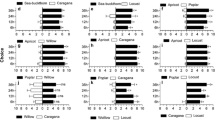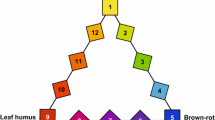Summary
-
1.
After a brief review of larval polyphenism with regard to colouration and behaviour of E. ello, experiments bearing on the influence of environmental factors upon the determination of the various color forms are described.
-
2.
Larvae growing up singly develop into the green, the brown, or, rarely, into the greengrey form. With higher population densities the proportion of the green and greengrey larvae decreases while the proportion of brown ones increases; in addition, a blue and a greenblue type appear. In still more crowded populations the blue form gradually replaces all others (Fig. 8)
-
3.
The occurrence of brown larvae is crucially influenced by the food quality and obviously not by contacts among the larvae; on fresh Poinsettia shoots 20% of singly bred larvae turn brown; however, on nearly defoliated shoots their proportion rises to 70% (Fig. 3). The latter effect probably explains the increase of the brown form in moderately dense populations, where the foodplant is also heavily damaged by the larvae.
On another foodplant, Euphorbia cotinifolia, as many as 90% of single caterpillars are of the brown type.
-
4.
By contrast, the development of the blue and greenblue forms in very dense populations is largely determined by stimuli from the larvae themselves. The nature of these stimuli is still unknown. Mechanical irritation with a brush and withdrawal from or feeding to the larvae the juice they regurgitate when disturbed failed to change the color of singly raised individuals (Fig. 5).
-
5.
The different color forms exhibit varying degrees of flexibility of change into one or the other form, including reversal of some of the developmental pathways. Only the brown color form, which also differs from the others in a peculiar resting behaviour, is irreversibly determined after reaching the fourth instar (Fig. 7).
Similar content being viewed by others
Literatur
Croze, H.: Searching image in carrion crows. Z. Tierpsychol., Beih. 5, 1–85 (1970)
Curio, E.: Die Schutzanpassungen dreier Raupen eines Schwärmers (Lepidopt., Sphingidae) auf Galapagos. Zool. Jb. Abt. System. Ökol. u. Geogr. 92, 487–522 (1965).
Curio, E.: Die Messung des Selektionsvorteils einer Verhaltensweise. Verh. Dtsch. Zool. Ges. 64, 348–352 (1970a).
Curio, E.: Die Selektion dreier Raupenformen eines Schwärmers (Lepidopt., Sphingidae) durch einen Anolis (Rept., Iguanidae). Z. Tierpsychol. 27, 899–914 (1970b)
Curio, E.: Validity of the selective coefficient of a behaviour trait in Hawkmoth larvae. Nature (Lond.) 228, 382 (1970c).
Drooz, A. T.: Aggregation affects color of elm spanworm larvae. U.S. Forest Res. Note SE 13 (1963).
Drooz, A. T.: Color studies of reared elm spanworm larvae and pupae. Ann. ent. Soc. Am. 59, 568–573 (1966).
Gruys, P.: Growth in Bupalus piniarius (Lepidoptera; Geometridae) in relation to larval population density. Verh. 1 of Res. Inst. Nature Management 1–127 (1970).
Iwao, S.: Studies on the phase variation and related phenomena in some lepidopterous insects. Memoirs College Agricult. (Kyoto Univ.) 84 1–80 (1962).
Iwao, S.: Some effects of grouping in lepidopterous insects. Colloq. Intern. C.N.R.S. 173, 185–212 (1968).
Iwao, S.: The western tent caterpillar: qualitative differences and the action of natural enemies. Res. Popul. Ecol 12, 81–99 (1970).
Iwao, S., Wellington, W. G.: The influence of behavioral differences among tentcaterpillar larvae on predation by a pentatomid bug. Can. J. Zool. 48, 896–898 (1970).
Mayr, E.: Animal species and evolution, 797 p. Cambridge, Mass.: Harvard Univ. Press 1963.
Nuorteva, P.: Die Rolle der Speichelsekrete im Wechselverhältnis zwischen Tier und Nahrungspflanze bei Homopteren und Heteropteren. Ent. exp. appl. 1, 41–49 (1958).
Sasakawa, M.: Phase polymorphism of the larger pellucid hawk moth, Cephonodes hylas L. Sphingidae. Effect of population density on the larval coloration and development. Sci. Rep. Kyoto Pref. Univ. Agr. 19, 29–36 (1967).
Sharov, A. G.: De Exaereta ulmi Schiff., een schadelijk insect van de boosauplantingen der Steppenzone. Zool. Zh. 32, 494–607 (1953).
Author information
Authors and Affiliations
Additional information
Mit Unterstützung der Deutschen Forschungsgemeinschaft.
Rights and permissions
About this article
Cite this article
Schneider, G. Über den einfluß verschiedener umweltfaktoren auf den färbungspolyphänismus der Raupen des tropisch-amerikanischen schwärmers Erinnyis ello L. (Lepidopt., Sphingid.). Oecologia 11, 351–370 (1973). https://doi.org/10.1007/BF00345704
Received:
Issue Date:
DOI: https://doi.org/10.1007/BF00345704




